Hi I have a 1D radial profile of a sample across a pipe (fig_1). One data point (along the orange straight line) is acquired at each "band" from the image. The resolution (x,y,z) of each data point is 100um x 100um x 1000um.
 (fig_1)
(fig_1)
However in order to produce a quantitative image, each data point in the 1D profile must be re-scaled by multiplying with a constant C. Where C is:
 (fig_2)
(fig_2)
Where, phi0 = 0.35, A = cross-section A of a circular pipe, v = velocity across a pipe cross-section. S = signal (data points). At the end they produce a 1D profile as such.
 (fig_3)
(fig_3)
My question is, how do I calculate the integral over the area (highlighted in red box, fig_2)?
In case I have missed any details I have provided the snippet of the text.
Comparison of radially averaged profile from a quantitative 2D image and 1D image is:
Ps: I have gotten around this problem by acquiring a 2D image from which I have calculated a 1D radially averaged intensity profile. 2D profile is quantitative and works fine, however I would like to know how I can make my 1D data quantitative as well.
